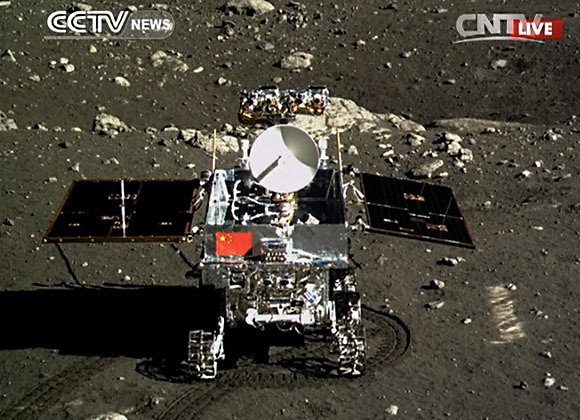 |
| China's Yutu, "Jade Rabbit," lunar rover, the first such vehicle operated on the Moon since 1976 [CCTV]. |
Official sources in Beijing report China's lunar rover Yutu “experienced a mechanical abnormality" and "scientists are organizing repairs."
The problem occurred “due to the complicated lunar surface environment," just before local sunset at the Chang’e-3 landing site on Saturday, January 25, Xinhua reported, citing a report from SASTIND, China’s State Administration of Science Technology and Industry for National Defense.
No further details were available from official sources early Sunday, Beijing time (UT +8 hours).
Unofficial sources, however, say the rover's solar panels may have failed to retract when ground controllers were preparing Yutu for hibernation ahead of local sunset on Saturday, and the start of a second 330 hour-long lunar night since successful deployment from the Chang’e-3 lander, December 14.
Whether the anomaly permanently disables the rover may be undetermined. Both the Chang’e-3 lander and Yutu depend on solar power, so communicated efforts to resolve the issue may have had to be suspended before nightfall to conserve a base of power to sustain the small robot through the long night ahead.
Retracted solar panels also may be critical to protecting the rover’s components over the two weeks of cold and darkness before the next local sunrise on February 9. The Mare Imbrium landing site’s latitude, with its higher angles of incidence sunlight than available at the equator, might require the lander and rover both experience a shorter period of peak charging, a shorter time when the Sun is higher in the sky, than strictly the time between dawn and dusk.
Meanwhile, with no problems of its own reported, the stationary Chang'e-3 lander, Xinhua reported, successfully began its own second 14 day-long period of required dormancy period on Friday.
After their first hibernation periods ended two weeks ago the optical telescope carried out observations using an extreme ultraviolet (UV) camera, observing Earth’s plasma-sphere, which is among other successful operations reported among “Preliminary Science Results” released by the Chinese Academy of Sciences a week ago.
UHF communications between the lander and Yutu were also successfully tested.
The Chang'e-3 mission makes China only the third nation to soft-land a spacecraft on the Moon, the first since Luna 24 in 1976, and whatever the outcome of its present challenges, Yutu is only the third remote- operated rover deployed on the Moon since Lunokhod 2 in 1973, which also used solar power but was kept warm through four lunar nights using heat generated by a radioisotope decay heater.
Some Related Posts:
Chang'e begins long-term science mission (January 18, 2014)
Preliminary Science Results from Chang'e-3 (January 16, 2014)
Chang'e-3 and Yutu survive first lunar night (January 14, 2014)
Chang'e-3 APXS delivers its first surface analysis (January 1, 2014)
Chang'e-3 lander and Yutu rover from LRO (December 31, 2013)
The problem occurred “due to the complicated lunar surface environment," just before local sunset at the Chang’e-3 landing site on Saturday, January 25, Xinhua reported, citing a report from SASTIND, China’s State Administration of Science Technology and Industry for National Defense.
No further details were available from official sources early Sunday, Beijing time (UT +8 hours).
Unofficial sources, however, say the rover's solar panels may have failed to retract when ground controllers were preparing Yutu for hibernation ahead of local sunset on Saturday, and the start of a second 330 hour-long lunar night since successful deployment from the Chang’e-3 lander, December 14.
Whether the anomaly permanently disables the rover may be undetermined. Both the Chang’e-3 lander and Yutu depend on solar power, so communicated efforts to resolve the issue may have had to be suspended before nightfall to conserve a base of power to sustain the small robot through the long night ahead.
Retracted solar panels also may be critical to protecting the rover’s components over the two weeks of cold and darkness before the next local sunrise on February 9. The Mare Imbrium landing site’s latitude, with its higher angles of incidence sunlight than available at the equator, might require the lander and rover both experience a shorter period of peak charging, a shorter time when the Sun is higher in the sky, than strictly the time between dawn and dusk.
Meanwhile, with no problems of its own reported, the stationary Chang'e-3 lander, Xinhua reported, successfully began its own second 14 day-long period of required dormancy period on Friday.
After their first hibernation periods ended two weeks ago the optical telescope carried out observations using an extreme ultraviolet (UV) camera, observing Earth’s plasma-sphere, which is among other successful operations reported among “Preliminary Science Results” released by the Chinese Academy of Sciences a week ago.
UHF communications between the lander and Yutu were also successfully tested.
The Chang'e-3 mission makes China only the third nation to soft-land a spacecraft on the Moon, the first since Luna 24 in 1976, and whatever the outcome of its present challenges, Yutu is only the third remote- operated rover deployed on the Moon since Lunokhod 2 in 1973, which also used solar power but was kept warm through four lunar nights using heat generated by a radioisotope decay heater.
Some Related Posts:
Chang'e begins long-term science mission (January 18, 2014)
Preliminary Science Results from Chang'e-3 (January 16, 2014)
Chang'e-3 and Yutu survive first lunar night (January 14, 2014)
Chang'e-3 APXS delivers its first surface analysis (January 1, 2014)
Chang'e-3 lander and Yutu rover from LRO (December 31, 2013)

1 comment:
i m feel so happy when read your blog which provide so good & informatics content Thanks for sharing Such as information.Free Solar Panels
Post a Comment